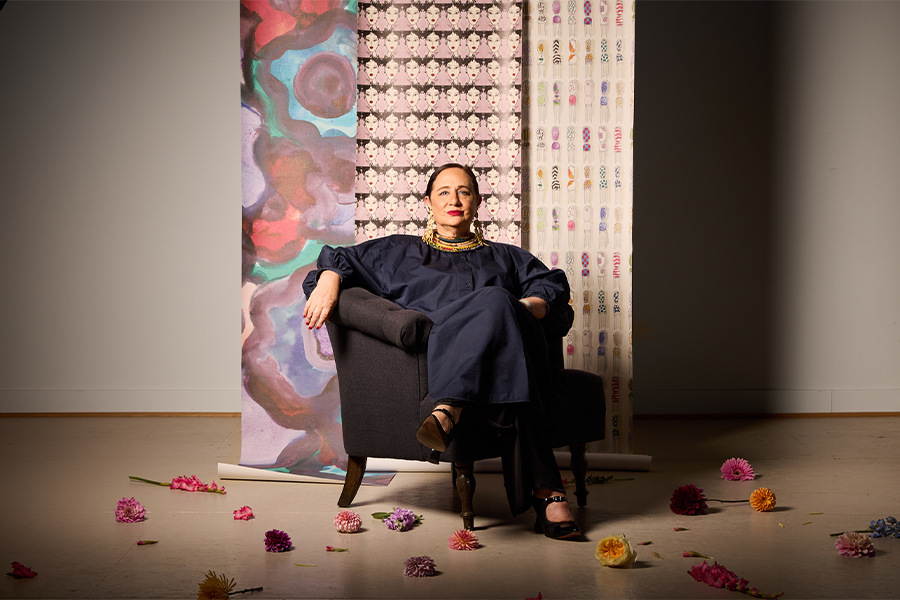From sustainability to simplicity, a range of themes inform the work of these two Northern England-based talents.
Charlie Whinney

In celebration of the English Lake District’s UNESCO status, Whinney’s Mountains We Made sculpture is created with a series of 10 steam bent sections
Charlie Whinney began to exercise his artistic muscles at a young age through writing and painting. Even though he displayed talent, Whinney had no plan to pursue the practice professionally. “I never thought I could do it as an actual job until I found myself making large sculptures in my 20s after studying architecture, furniture, and design for sustainability,” he says. “I always felt proud but also a bit guilty about the art side of my work.”
Based in the North of England, ensconced in the woodlands of the Lake District National Park, Whinney continues to explore the synthesis of his interests in art and sustainability. His eponymous studio has generated awe for steam bending wood to redefine its potential as a medium. “I am fascinated by materials, exploring the circular feedback between the artist’s action in the physical world and imagination,” he says. His techniques render locally sourced timber into simple creations, like abstract ribbons or even floral pieces, and large-scale décor and installations.

Whinney’s sculptures for the 2021 Chelsea Flower Show integrate with the garden
For instance, sculptures and furniture fashioned by Whinney from oak thinnings recently populated the Royal Horticultural Society Garden for the 2021 Chelsea Flower Show in London. His work has also caught the eye of Tony Chi, with whom he has collaborated on several hotel projects, including the Andaz Tokyo, where a hanging sculpture crafted from a single oak tree forms four swooping arches.
Circularity remains paramount in Whinney’s practice. “We tend to make work where it would exist regardless of us, and we do it using low/zero carbon, eco-friendly materials and processes within the context of the circular economy,” he says. “It’s not always perfect, and we’re always improving but working in this way allows me to fully explore my work and be creative.” The evolution of sustainability will continue to inform Whinney’s philosophy. “I now realize the art and love of beauty allows the ecological and social aspects of work to exist at all,” he adds.
Alarah Gee

School was a drag for Alarah Gee when she was young—until art class. Unlike other subjects, art stirred an emotional reward that eclipsed the rest of her curriculum. “I wasn’t interested, nor curious, about anything else at that point in my life,” she says. “Whether it be turning brass on a lathe, chiseling away at a block of solid walnut, or applying oil paint to a canvas, I was hooked.”

Plantasia experiments with the constructive and textural behaviors of color in spatial compositions
Gee, who is based in Yorkshire in the North of England, learned just as much from observing her peers as she did her teachers. She attended the Leeds College of Art Foundation in the UK with “an attitude of mind not method,” she says, which prioritized individual perception and experimentation. She began to weave together prints that studied the potential of simple lines and geometric forms. Though methodical and precise, Gee’s artwork explores playful constructs liberated from the burden of context. “My work is an enquiry into shape and structure and the economy of line,” she says. “I challenge my environment and highlight what is necessary and sufficient using a variety of mediums. I then construct these new realities.”
Her portfolio of drawings and paintings speaks volumes in its simplicity. “The aim is to find my own sense of visual equilibrium by balancing abstract forms and color contrasts with the use of line,” Gee says. A new collection examines her constructions in color to unpack questions of spatial composition from the opposition of light and dark. “There are no limitations,” she says. “It is constantly evolving, and that is the beauty of a creative field.”
This article originally appeared in HD’s January 2022 issue.
More from HD:
Fogarty Finger Responds to How People Live and Work Today
East Meets West at Lily in San Francisco
New Hotels Bring Fresh Perspectives to Chicago


